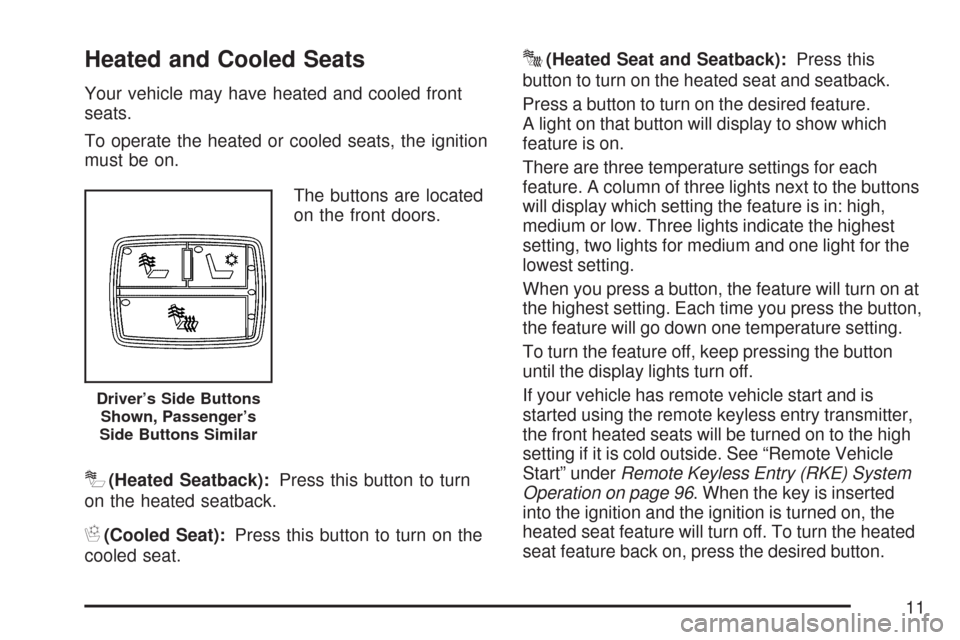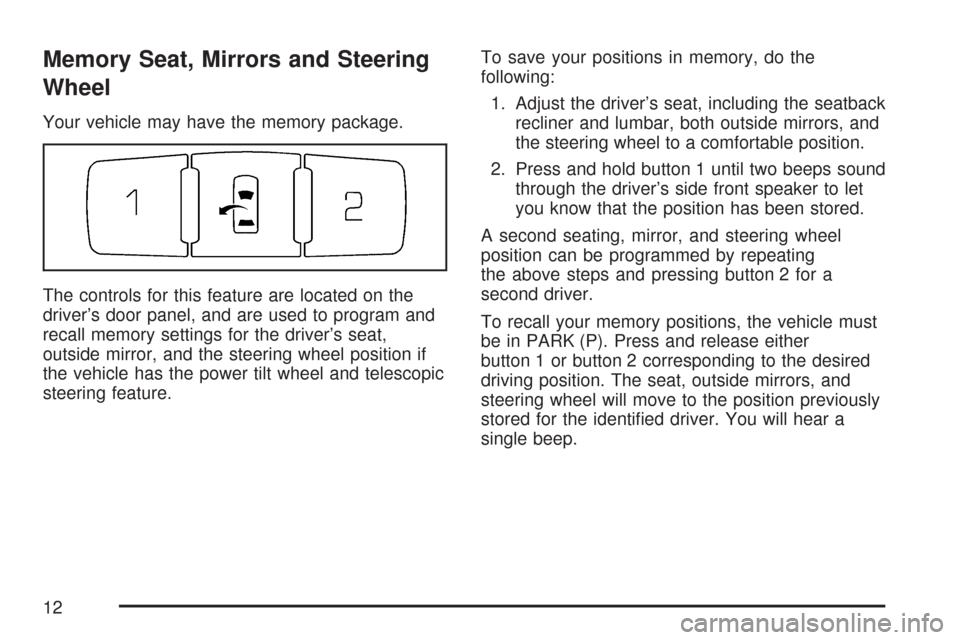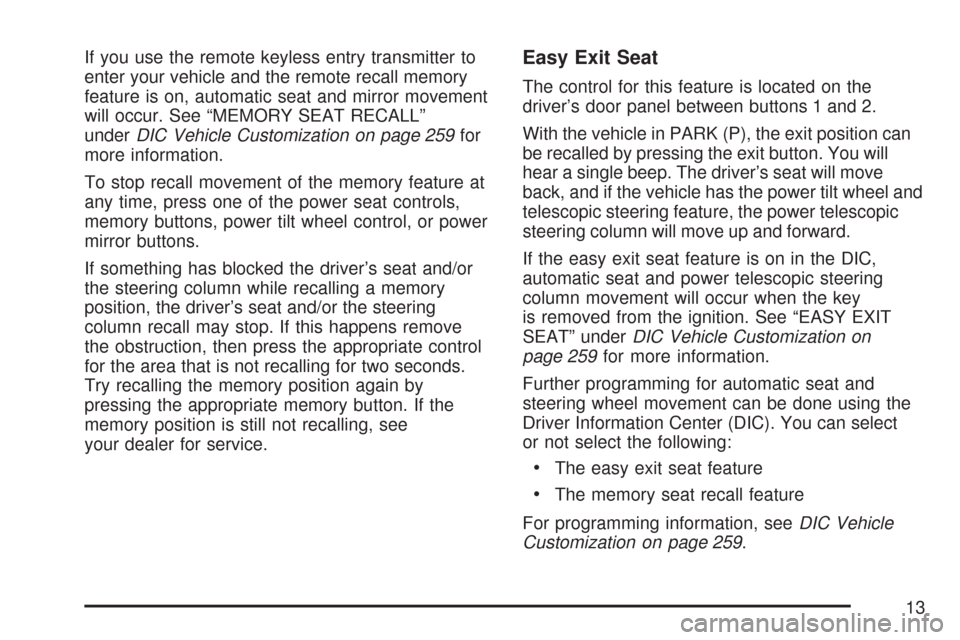CADILLAC DTS 2007 1.G User Guide
Manufacturer: CADILLAC, Model Year: 2007, Model line: DTS, Model: CADILLAC DTS 2007 1.GPages: 518, PDF Size: 2.77 MB
Page 11 of 518

Heated and Cooled Seats
Your vehicle may have heated and cooled front
seats.
To operate the heated or cooled seats, the ignition
must be on.
The buttons are located
on the front doors.
I(Heated Seatback):Press this button to turn
on the heated seatback.
H(Cooled Seat):Press this button to turn on the
cooled seat.
J(Heated Seat and Seatback):Press this
button to turn on the heated seat and seatback.
Press a button to turn on the desired feature.
A light on that button will display to show which
feature is on.
There are three temperature settings for each
feature. A column of three lights next to the buttons
will display which setting the feature is in: high,
medium or low. Three lights indicate the highest
setting, two lights for medium and one light for the
lowest setting.
When you press a button, the feature will turn on at
the highest setting. Each time you press the button,
the feature will go down one temperature setting.
To turn the feature off, keep pressing the button
until the display lights turn off.
If your vehicle has remote vehicle start and is
started using the remote keyless entry transmitter,
the front heated seats will be turned on to the high
setting if it is cold outside. See “Remote Vehicle
Start” underRemote Keyless Entry (RKE) System
Operation on page 96. When the key is inserted
into the ignition and the ignition is turned on, the
heated seat feature will turn off. To turn the heated
seat feature back on, press the desired button.
Driver’s Side Buttons
Shown, Passenger’s
Side Buttons Similar
11
Page 12 of 518

Memory Seat, Mirrors and Steering
Wheel
Your vehicle may have the memory package.
The controls for this feature are located on the
driver’s door panel, and are used to program and
recall memory settings for the driver’s seat,
outside mirror, and the steering wheel position if
the vehicle has the power tilt wheel and telescopic
steering feature.To save your positions in memory, do the
following:
1. Adjust the driver’s seat, including the seatback
recliner and lumbar, both outside mirrors, and
the steering wheel to a comfortable position.
2. Press and hold button 1 until two beeps sound
through the driver’s side front speaker to let
you know that the position has been stored.
A second seating, mirror, and steering wheel
position can be programmed by repeating
the above steps and pressing button 2 for a
second driver.
To recall your memory positions, the vehicle must
be in PARK (P). Press and release either
button 1 or button 2 corresponding to the desired
driving position. The seat, outside mirrors, and
steering wheel will move to the position previously
stored for the identi�ed driver. You will hear a
single beep.
12
Page 13 of 518

If you use the remote keyless entry transmitter to
enter your vehicle and the remote recall memory
feature is on, automatic seat and mirror movement
will occur. See “MEMORY SEAT RECALL”
underDIC Vehicle Customization on page 259for
more information.
To stop recall movement of the memory feature at
any time, press one of the power seat controls,
memory buttons, power tilt wheel control, or power
mirror buttons.
If something has blocked the driver’s seat and/or
the steering column while recalling a memory
position, the driver’s seat and/or the steering
column recall may stop. If this happens remove
the obstruction, then press the appropriate control
for the area that is not recalling for two seconds.
Try recalling the memory position again by
pressing the appropriate memory button. If the
memory position is still not recalling, see
your dealer for service.Easy Exit Seat
The control for this feature is located on the
driver’s door panel between buttons 1 and 2.
With the vehicle in PARK (P), the exit position can
be recalled by pressing the exit button. You will
hear a single beep. The driver’s seat will move
back, and if the vehicle has the power tilt wheel and
telescopic steering feature, the power telescopic
steering column will move up and forward.
If the easy exit seat feature is on in the DIC,
automatic seat and power telescopic steering
column movement will occur when the key
is removed from the ignition. See “EASY EXIT
SEAT” underDIC Vehicle Customization on
page 259for more information.
Further programming for automatic seat and
steering wheel movement can be done using the
Driver Information Center (DIC). You can select
or not select the following:
The easy exit seat feature
The memory seat recall feature
For programming information, seeDIC Vehicle
Customization on page 259.
13
Page 14 of 518

Power Reclining Seatbacks
Your seats have power
reclining seatbacks. Use
the vertical power seat
control located on the
outboard side of the seat
to operate them.
To recline the seatback, press the control
toward the rear of the vehicle.
To raise the seatback, press the control toward
the front of the vehicle.
14
Page 15 of 518

{CAUTION:
Sitting in a reclined position when your
vehicle is in motion can be dangerous.
Even if you buckle up, your safety belts
cannot do their job when you are reclined
like this.
The shoulder belt cannot do its job
because it will not be against your body.
Instead, it will be in front of you. In a
crash, you could go into it, receiving neck
or other injuries.
CAUTION: (Continued)
CAUTION: (Continued)
The lap belt cannot do its job either. In a
crash, the belt could go up over your
abdomen. The belt forces would be there,
not at your pelvic bones. This could cause
serious internal injuries.
For proper protection when the vehicle is
in motion, have the seatback upright.
Then sit well back in the seat and wear
your safety belt properly.
Do not have a seatback reclined if your vehicle is
moving.
15
Page 16 of 518

Head Restraints
Adjust the head restraint so that the top of the
restraint is at the same height as the top of
the occupant’s head. This position reduces the
chance of a neck injury in a crash.
The height of all the head restraints can be
adjusted.To raise a front seat
head restraint, pull up on
the restraint. To lower it,
press the button, located
on the top of the
seatback, and push the
head restraint down.
To adjust the height of a rear seat head restraint,
pull up or push down on the restraint.
The front seat head restraints can also tilt forward
and rearward. The rear seat head restraints do
not tilt.
16
Page 17 of 518

Center Seat
Your vehicle may have a front center seat. This
seat can be converted to a storage area by
lowering the seatback. SeeCenter Flex Storage
Unit on page 156.
For information on safety belts for this position,
seeCenter Front Passenger Position on page 35.
Rear Seats
Heated Seats
Your vehicle may have heated rear seats.
To operate the rear heated seats, the ignition
must be on.
The buttons are located
on the rear doors.
I(Heated Seatback):Press this button to turn
on the heated seatback.
J(Heated Seat and Seatback):Press this
button to turn on the heated seat and seatback.
17
Page 18 of 518

Press a button to turn on the desired feature. A
light on that button will display to show which
feature is on.
There are three temperature settings for each
feature. A column of three lights next to the
buttons will display which setting the feature is in:
high, medium or low. Three lights indicate the
highest setting, two lights for medium and one light
for the lowest setting.
When you press a button, the feature will turn on
at the highest setting. Each time you press the
button, the feature will go down one temperature
setting.
To turn the feature off, keep pressing the button
until the display lights turn off.
Rear Seat Pass-Through Door
Your vehicle has a pass-through door that provides
access to the trunk from the rear seats. See
“Rear Seat Pass-Through Door” underTrunk on
page 106.
Power Lumbar
Your vehicle may be equipped with four-way
lumbar support, without the massage feature, for
the outboard rear seat positions.
The rear lumbar support
controls are located on
the rear doors in
front of the heated seat
buttons.
To turn on the lumbar support feature, press the
front of the control to increase support or rearward
to decrease support. The lumbar control can
also be moved up and down to adjust the location
of the support.
The ignition does not need to be on for the power
lumbar feature to work.
18
Page 19 of 518

Safety Belts
Safety Belts: They Are for Everyone
This part of the manual tells you how to use
safety belts properly. It also tells you some things
you should not do with safety belts.
{CAUTION:
Do not let anyone ride where he or she
cannot wear a safety belt properly. If you
are in a crash and you are not wearing a
safety belt, your injuries can be much
worse. You can hit things inside the
vehicle or be ejected from it. You can be
seriously injured or killed. In the same
crash, you might not be, if you are
buckled up. Always fasten your safety
belt, and check that your passengers’
belts are fastened properly too.
{CAUTION:
It is extremely dangerous to ride in a
cargo area, inside or outside of a vehicle.
In a collision, people riding in these areas
are more likely to be seriously injured or
killed. Do not allow people to ride in any
area of your vehicle that is not equipped
with seats and safety belts. Be sure
everyone in your vehicle is in a seat and
using a safety belt properly.
Your vehicle has indicators to remind you and
your passengers to buckle your safety belts. See
Safety Belt Reminder Light on page 225and
Passenger Safety Belt Reminder Light on
page 225.
In most states and in all Canadian provinces, the
law says to wear safety belts. Here is why:
They work.
19
Page 20 of 518

You never know if you will be in a crash. If you do
have a crash, you do not know if it will be a
bad one.
A few crashes are mild, and some crashes can be
so serious that even buckled up, a person
would not survive. But most crashes are in
between. In many of them, people who buckle up
can survive and sometimes walk away. Without
belts they could have been badly hurt or killed.
After more than 40 years of safety belts in
vehicles, the facts are clear. In most crashes
buckling up does matter... a lot!Why Safety Belts Work
When you ride in or on anything, you go as fast
as it goes.
Take the simplest vehicle. Suppose it is just a
seat on wheels.
20